May 9, 2018
L&S Risk Pulse™ Score

Caution
Long-term macroeconomic conditions are strong, but at least several core economic indicators show weakness with noteworthy but outlying risk that requires monitoring. Valuations are approaching high for a majority of stocks.
L&S Risk Pulse™ Insights – “I Don’t Think We’re In Kansas Anymore, Toto”
General Comments
Like the political environment, stocks seem to be lacking leadership. The semiconductor and jumbo-cap technology stocks that led the market throughout last year have stumbled. Interest rates have moved modestly higher, yet the banks and financial services stocks, companies that would be prime beneficiaries of higher interest rates, have lost their way. Industrial stocks that typically do well later in the economic cycle have also struggled. The high-flying defense stocks are under fire. Materials stocks that would benefit from higher inflation and rising commodity prices also seem to have lead shoes. Where is the leadership?
The lack of leadership is a significant concern for us as the market seems directionless. The good news is that markets have not made lower lows after the early February swoon. The bad news is that without direction or leadership it is difficult to expect markets to return to the old highs. Perhaps, even more disconcerting, is the fact that those groups that we would expect to perform under certain circumstances are not behaving as expected. In fact, companies that reported excellent results are not being rewarded by the market.
There are other concerns as well. The Purchasing Managers surveys have weakened. From global synchronized growth, we are looking at a global synchronized slowdown. Admittedly, the slowdown is not yet severe, and indicator levels still reflect reasonable growth ahead. The direction of the indicators is the problem. The USA, China, Germany, Spain, Italy, France, the Eurozone, Emerging Markets, and Global indicators all have slowed over the past several months. We wish we knew the answer to whether the slowdown is over or whether it has really just begun.
Concerns over slower growth were exacerbated when Caterpillar suggested that “the first quarter adjusted profit per share will be the high watermark for the year.” Cat usually shows the highest profit during the second calendar quarter, so why were they suggesting that the peak has passed? Certainly Cat will be hurt by higher steel tariffs which raises the price of materials needed to manufacture their products. Even with announced product price increases, Cat is worried that they will be unable to recover all of the cost increases they face for the remainder of the year. If slower growth leads to peaking profits and potentially declining profit margins, how much higher can the market go?
We have seen a massive change in investor psychology and orientation. Elation over tax cuts has turned to concern over deficits. Global synchronized growth has morphed into a global synchronized slowdown. A victorious Trump has quickly become a worry over mid-term election losses. Deregulation has faded to concerns that giant technology stocks with access to immense personal data will need to be regulated. Complacency is over, and investors will need to work much harder to earn meaningful returns. I don’t think we’re in Kansas anymore, Toto.
Conclusion
This has been one of the longest economic cycles in U.S. history, and we do not see an end just yet. Still, we recognize that we are closer to the end of the expansion than we were a year ago. Concerns over slower growth, weaker margins, political risks, and the lateness of the cycle will all work to lower potential market multiples. It will be a much more difficult environment for investors.
It is, however, a market that will reward the efforts necessary to find good ideas and good industries and sectors. Active managers can add tremendous value in this market. The ability to raise cash for our most conservative and tactical clients should also add value. We remain concerned over the lack of leadership, but we are encouraged that active and tactical managers can add value in different ways.
